Aha, yeah; aha, yeah, yeah drumset and eerie piano tune. Minute one, I’m in a 23rd century cathedral, electric organ ushers in neo-acolytes into the friendly arms of the one true faith. We are all gathered under neon-lights standing over shiny reflecting white tiles beneath us. There are no walls and no doors, only one faith. Minute two, it’s the queue for all of us gathered to begin our absolutions. Everyone starts bobbing in place to the beat. We are one, we are one faith. We are mumber. Cool.You can listen to it here
May 27, 2010
A Song
Well, here is a song, done with my synths and stuff. DX7, Juno, and DX drums. Did some processing and sequencing in Ableton Live. Also had some guitar. I have no idea what to classify this as. It is called "Mumber," because I misspelled "number 1" when naming it and I decided to stick with it. A friend describes it like this:
May 11, 2010
New Stuff and Updates
Let's start with the S-770. After spending a few days scratching my head, trying to figure out how to get this thing working, I finally found a solution. It is somewhat convoluted, but it works. Roland's website has the OS and a program for writing the startup disks. You will need a DD floppy disk though, and they aren't common. You can, however, format a "normal" 1.44MB HD floppy disk to 770kb. All you have to do is tape over the hole on the bottom right corner. This will make it read as a DD disk. If you are running Windows XP or later you can't format disks to 770kb DD. For that I used Alkonost MaxFormat, very useful for formatting floppies. After formatting the disk, write the OS with Roland's program and you are all set!
I ordered a SCSI Zip drive from Amazon and I dug up a bunch of old Zip disks. Now, instead of only having 40MB of storage, I will have hundreds of megabytes of storage. Lots of samples. I keep reading reviews of this thing, and it makes me more and more excited to start playing around with it:
In other news, a friend of mine pointed me to a website that sells PCBs for stomp box clones. I ordered a Zvex Woolly Mammoth clone and a fuzz that uses a 4049 chip (basically it sounds wild, unlike any other fuzz, its kind of like the Red Llama I was making earlier, which I abandoned). I also bought the parts for everything, so hopefully I'll have two new fuzz pedals to make loud guitar noises with.
Alos purchased: a parallel printer to USB adapter for my EPROM programmer. Oh yeah, apparently you need a parallel printer to use the EROM programmer, so the Ensoniq is still not working. Soon though, hopefully.
I ordered a SCSI Zip drive from Amazon and I dug up a bunch of old Zip disks. Now, instead of only having 40MB of storage, I will have hundreds of megabytes of storage. Lots of samples. I keep reading reviews of this thing, and it makes me more and more excited to start playing around with it:
Most impressive in 1990 was the S770, a 3U rackmount sampler that, nearly 15 years later, remains a superb instrument. It was 24-voice polyphonic, incorporated an internal hard disk drive, offered sample RAM that was expandable up to 16MB, had digital inputs and outputs, offered 20-bit A-D and D-A conversion, supported all the peripherals already launched, and was compatible with the existing S-series library. But it was not the S770's specification that held the two secrets of its excellence; these were rather more intangible. Firstly, there was the sample editing system, which was a hugely powerful and elegant synth in its own right, but which was overlooked by the public at large. Secondly, there was the audio quality. Thanks to a new reproduction method called Differential Interpolation, the S770 eliminated the grainy distortion that appeared when you played at low pitches on other manufacturers' samplers. Unfortunately, just as they had on the W30, Roland had missed a trick... once again, the S770's specification lacked the crucial words 'Akai' and 'compatible'. Had it been able to load and/or convert the Akai sample library, it might have gone on to become the new standard. But it didn't, so it didn't.Akai can eat it.
In other news, a friend of mine pointed me to a website that sells PCBs for stomp box clones. I ordered a Zvex Woolly Mammoth clone and a fuzz that uses a 4049 chip (basically it sounds wild, unlike any other fuzz, its kind of like the Red Llama I was making earlier, which I abandoned). I also bought the parts for everything, so hopefully I'll have two new fuzz pedals to make loud guitar noises with.
Alos purchased: a parallel printer to USB adapter for my EPROM programmer. Oh yeah, apparently you need a parallel printer to use the EROM programmer, so the Ensoniq is still not working. Soon though, hopefully.
May 3, 2010
Electronic Components Part 3: R
V = IR
Welcome to the third part. This will cover resistance. For us armature electronic engineers the component that we will use the most are resistors. Every circuit uses resistors. Actually, every circuit uses capacitors too, but not as frequently as resistors.
Resistors, as the name implies, cause resistance in the circuit. Using our hydraulic analogy, think of a resistor as a crimp in the pipe that restricts the flow of water. This is measured in ohms.
So V is the pressure, I is the rate of flow, and R is the resistance of the flow.
Let's set up a simple circuit consisting of a power source (V) and one resistor, and an ammeter.
Lets say we are using a 10 volt battery and we have a 100 ohm resistor.
Using simple algebra we can rearrange V=IR to solve for I. I=V/R.
I = 10/100
I = 0.1 amperes (amps), or 100 mA. This is the reading we would see on the ammeter.
If we increase the resistance and keep V the same, the current will decrease. If we decrease the resistance, the current will increase.
It is actually much harder to under stand the "why" than it is to do the math with this equation.
The next installment will be an introduction to the various electronic components that you will frequently see in a circuit.
Welcome to the third part. This will cover resistance. For us armature electronic engineers the component that we will use the most are resistors. Every circuit uses resistors. Actually, every circuit uses capacitors too, but not as frequently as resistors.
Resistors, as the name implies, cause resistance in the circuit. Using our hydraulic analogy, think of a resistor as a crimp in the pipe that restricts the flow of water. This is measured in ohms.
So V is the pressure, I is the rate of flow, and R is the resistance of the flow.
Let's set up a simple circuit consisting of a power source (V) and one resistor, and an ammeter.
Lets say we are using a 10 volt battery and we have a 100 ohm resistor.
Using simple algebra we can rearrange V=IR to solve for I. I=V/R.
I = 10/100
I = 0.1 amperes (amps), or 100 mA. This is the reading we would see on the ammeter.
If we increase the resistance and keep V the same, the current will decrease. If we decrease the resistance, the current will increase.
It is actually much harder to under stand the "why" than it is to do the math with this equation.
The next installment will be an introduction to the various electronic components that you will frequently see in a circuit.
May 2, 2010
Fender Bassman Update
I was wrong. I wasn't a blown capacitor. It was two blown resistors. And a blown capacitor. The smoke was from the resistors though, not the capacitor. The good news is that these are cheap parts; two 100 ohm resistors and a 5uf capacitor. I have no idea why they blew, but if i had to guess I'd say it was due to age. It should be an easy fix.
Amp Guts Porn:


Here you can see the two blown resistors
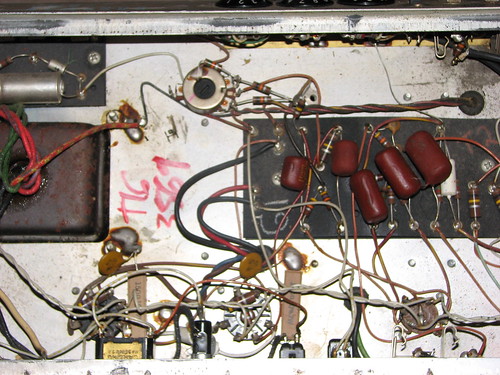
Blown cap in the bottom of this picture. It's really hard to see.
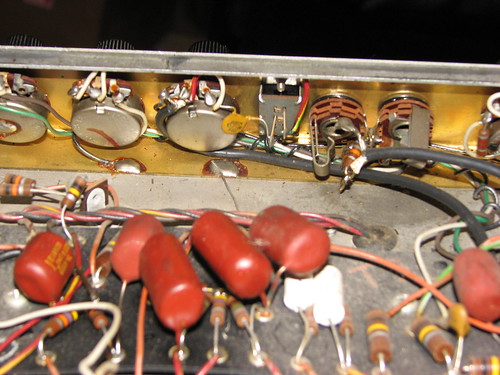
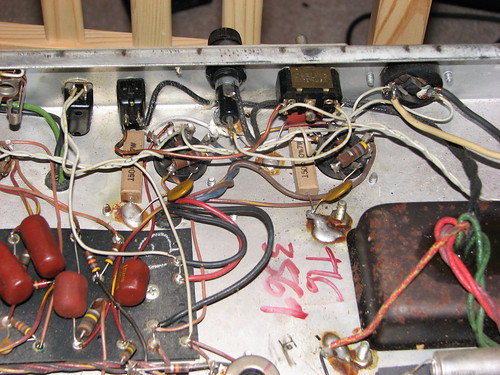
Another view of the blown cap.
Amp Guts Porn:


Here you can see the two blown resistors

Blown cap in the bottom of this picture. It's really hard to see.


Another view of the blown cap.
Roland S-770: Who would have thought I need this old stuff?
On a whim I bought a Roland S-770 sampler. It was made in 1989. Stock it features 1MB of memory, expandable to 16MB. The one I bought has the full 16MB. It has ADSR filters and come cool editing capabilities for 1989, however, I have not used it yet. The internal hard drive, used to store the samples (a full 40MB hard drive!) was busted. It turned on, but when it searched for a hard drive there was a clicking-grinding noise, so I can't use it yet. Eventually I will swap the floppy drive with a Zip drive (and that will replace the hard drive too), but for now I've been trying to get it to fully start up. This requires booting the thing from a floppy drive. The fun part is that it will only take a 770kb DD floppy. I am not sure that I have actually ever seen one of those before, 1.44MB yes, but not 770kb.
Zip drives and DD floppies. Who would have thought I'd be needing these things in 2010.
Anyway, here be some guts:

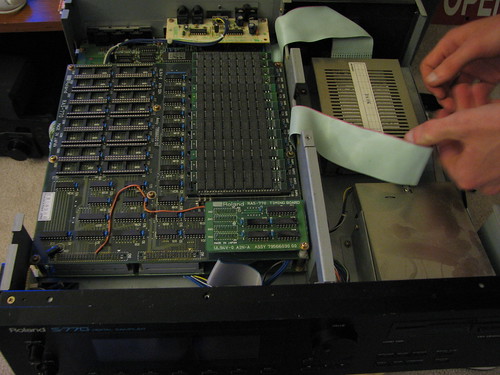
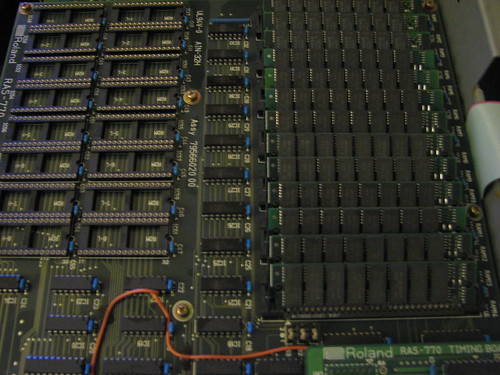

Zip drives and DD floppies. Who would have thought I'd be needing these things in 2010.
Anyway, here be some guts:




Subscribe to:
Posts (Atom)

